GaN Nanowire Array for Charge Transfer in Hybrid GaN/P3HT:PC71BM Photovoltaic Heterostructure Fabricated on Silicon
Abstract
:1. Introduction
2. Materials and Methods
2.1. Growth of GaN Nanowires
2.2. Preparation of the Organic Blends
2.3. Structure Fabrication
3. Characterization
3.1. Scanning Electron Microscopy and Morphological Feature Analysis
3.2. Volt-Ampere Characteristics Measurement
3.3. Mott–Schottky Analysis
4. Results and Discussion
4.1. Nanostructure Morphology
4.2. Current–Voltage Characterization
4.3. Mott–Schottky Analysis
5. Conclusions
Author Contributions
Funding
Acknowledgments
Conflicts of Interest
References
- Scharber, M.; Sariciftci, N. Efficiency of bulk-heterojunction organic solar cells. Prog. Polym. Sci. 2013, 38, 1929–1940. [Google Scholar] [CrossRef] [PubMed] [Green Version]
- Müller-Buschbaum, P.; Thelakkat, M.; Fässler, T.F.; Stutzmann, M. Hybrid Photovoltaics—From Fundamentals towards Application. Adv. Energy Mater. 2017, 7, 1700248. [Google Scholar] [CrossRef] [Green Version]
- Koster, L.J.A.; Mihailetchi, V.D.; Blom, P.W.M. Ultimate efficiency of polymer/fullerene bulk heterojunction solar cells. Appl. Phys. Lett. 2006, 88, 093511. [Google Scholar] [CrossRef] [Green Version]
- Wang, M.; Li, Y.; Huang, H.; Peterson, E.D.; Nie, W.; Zhou, W.; Zeng, W.; Huang, W.; Fang, G.; Sun, N.; et al. Thickness dependence of the MoO3 blocking layers on ZnO nanorod-inverted organic photovoltaic devices. Appl. Phys. Lett. 2011, 98, 103305. [Google Scholar] [CrossRef] [PubMed]
- Davenas, J.; Ben Dkhil, S.; Cornu, D.; Rybak, A. Silicon Nanowire/P3HT Hybrid Solar Cells: Effect of the Electron Localization at Wire Nanodiameters. Energy Procedia 2012, 31, 136–143. [Google Scholar] [CrossRef] [Green Version]
- Das, N.; Biswas, S.; Sokol, P. The photovoltaic performance of ZnO nanorods in bulk heterojunction solar cells. J. Renew. Sustain. Energy 2011, 3, 033105. [Google Scholar] [CrossRef]
- Calarco, R.; Marso, M.; Richter, T.; Aykanat, A.I.; Meijers, R.; Hart, A.V.; Stoica, T.; Lueth, H. Size-dependent Photoconductivity in MBE-Grown GaN−Nanowires. Nano Lett. 2005, 5, 981–984. [Google Scholar] [CrossRef] [Green Version]
- Park, B.-N.; Uhlrich, J.J.; Kuech, T.F.; Evans, P.G. Electrical properties of GaN/poly(3-hexylthiophene) interfaces. J. Appl. Phys. 2009, 106, 13713. [Google Scholar] [CrossRef] [Green Version]
- Adachi, S. Properties of Group-IV, III-V and II-VI Semiconductors; Wiley: New York City, NY, USA, 2005. [Google Scholar]
- Deibel, C.; Mack, D.; Gorenflot, J.; Schöll, A.; Krause, S.; Reinert, F.; Rauh, D.; Dyakonov, V. Energetics of excited states in the conjugated polymer poly(3-hexylthiophene). Phys. Rev. B 2010, 81, 085202. [Google Scholar] [CrossRef] [Green Version]
- Richter, T.V.; Braun, C.H.; Link, S.; Scheuble, M.; Crossland, E.J.W.; Stelzl, F.; Wurfel, U.; Ludwigs, S. Regioregular Polythiophenes with Alkylthiophene Side Chains. Macromolecules 2012, 45, 5782–5788. [Google Scholar] [CrossRef]
- Kumar, P.; Guha, S.; Shahedipour-Sandvik, F.; Narayan, K.S. Hybrid n-GaN and polymer interfaces: Model systems for tunable photodiodes. Org. Electron. 2013, 14, 2818–2825. [Google Scholar] [CrossRef]
- Noh, J.-Y.; Lee, H.Y.; Lim, K.-W.; Ahn, H.S.; Yi, S.N.; Jeon, H.; Shin, M.J.; Yu, Y.M.; Ha, D.H. Effects of P3HT concentration on the electrical properties of the Au/PEDOT:PSS/P3HT/n-GaN hybrid junction structure. J. Korean Phys. Soc. 2017, 71, 349–354. [Google Scholar] [CrossRef]
- Feng, Q.; Shi, P.; Li, Y.-K.; Du, K.; Wang, Q.; Feng, Q.; Hao, Y. Hybrid solar cell based on polythiophene and GaN nanoparticles composite. Chin. Phys. B 2014, 23, 028802. [Google Scholar] [CrossRef]
- Hu, L.-F.; Wang, F.-X.; Deng, F.-X.; Zhao, Y.; Pan, G.-B. Polymer/porous GaN bulk heterojunction and its optoelectronic property. Appl. Surf. Sci. 2014, 314, 464–467. [Google Scholar] [CrossRef]
- Kim, M.; Shin, M.J.; Gwon, D.; Ahn, H.S.; Yi, S.N.; Kim, P.S.; Yoon, S.C.; Lee, C.; Park, J.; Shin, K.; et al. Development of the Hybrid Conjugated Polymer Solar Cell Based on GaN Quantum Dots. Jpn. J. Appl. Phys. 2013, 52, 1. [Google Scholar] [CrossRef]
- Tchutchulashvili, G.; Korona, K.P.; Mech, W.; Chusnutdinow, S.; Sobanska, M.; Klosek, K.; Zytkiewicz, Z.R.; Sadowski, W. Hybrid P3HT: PCBM/GaN nanowire/Si cascade heterojunction for photovoltaic application. J. Nanoparticle Res. 2020, 22, 1–9. [Google Scholar] [CrossRef] [Green Version]
- Klosek, K.; Sobanska, M.; Tchutchulashvili, G.; Żytkiewicz, Z.; Teisseyre, H. ; Kłopotowski, Łukasz Optimization of nitrogen plasma source parameters by measurements of emitted light intensity for growth of GaN by molecular beam epitaxy. Thin Solid Films 2013, 534, 107–110. [Google Scholar] [CrossRef]
- Wierzbicka, A.; Zytkiewicz, Z.R.; Kret, S.; Borysiuk, J.; Dluzewski, P.; Sobanska, M.; Klosek, K.; Reszka, A.; Tchutchulashvili, G.; Cabaj, A.; et al. Influence of substrate nitridation temperature on epitaxial alignment of GaN nanowires to Si(111) substrate. Nanotechnology 2012, 24, 035703. [Google Scholar] [CrossRef]
- Fernández-Garrido, S.; Kaganer, V.M.; Sabelfeld, K.K.; Gotschke, T.; Grandal, J.; Calleja, E.; Geelhaar, L.; Brandt, O. Self-Regulated Radius of Spontaneously Formed GaN Nanowires in Molecular Beam Epitaxy. Nano Lett. 2013, 13, 3274–3280. [Google Scholar] [CrossRef]
- Sobanska, M.; Dubrovskii, V.G.; Tchutchulashvili, G.; Klosek, K.; Zytkiewicz, Z.R. Analysis of Incubation Times for the Self-Induced Formation of GaN Nanowires: Influence of the Substrate on the Nucleation Mechanism. Cryst. Growth Des. 2016, 16, 7205–7211. [Google Scholar] [CrossRef]
- Borysiuk, J.; Zytkiewicz, Z.R.; Sobańska, M.; Wierzbicka, A.; Klosek, K.; Korona, K.; Perkowska, P.S.; Reszka, A. Growth by molecular beam epitaxy and properties of inclined GaN nanowires on Si(001) substrate. Nanotechnology 2014, 25, 135610. [Google Scholar] [CrossRef]
- Sobanska, M.; Wierzbicka, A.; Klosek, K.; Borysiuk, J.; Tchutchulashvili, G.; Gieraltowska, S.; Żytkiewicz, Z. Arrangement of GaN nanowires grown by plasma-assisted molecular beam epitaxy on silicon substrates with amorphous Al2O3 buffers. J. Cryst. Growth 2014, 401, 657–660. [Google Scholar] [CrossRef]
- Wierzbicka, A.; Tchutchulashvili, G.; Sobanska, M.; Klosek, K.; Minikayev, R.; Domagala, J.; Borysiuk, J.; Zytkiewicz, Z. Arrangement of GaN nanowires on Si(001) substrates studied by X-ray diffraction: Importance of silicon nitride interlayer. Appl. Surf. Sci. 2017, 425, 1014–1019. [Google Scholar] [CrossRef]
- Sobanska, M.; Klosek, K.; Zytkiewicz, Z.R.; Borysiuk, J.; Witkowski, B.S.; Lusakowska, E.; Reszka, A.; Jakiela, R. Plasma-assisted MBE growth of GaN on Si(111) substrates. Cryst. Res. Technol. 2011, 47, 307–312. [Google Scholar] [CrossRef]
- ImageJ Image processing and Analysis in Jawa. Available online: https://imagej.net (accessed on 11 September 2020).
- Schroder, D.K. Semiconductor Material and Device Characterization; John Wiley & Sons: New York City, NY, USA, 2015. [Google Scholar]
- Boix, P.P.; Garcia-Belmonte, G.; Muñecas, U.; Neophytou, M.; Waldauf, C.; Pacios, R. Determination of gap defect states in organic bulk heterojunction solar cells from capacitance measurements. Appl. Phys. Lett. 2009, 95, 233302. [Google Scholar] [CrossRef] [Green Version]
- Mott, N.F.; Gurney, R.W. Electronic Processes in Ionic Crystals; Oxford University Press: New York, NY, USA, 1940. [Google Scholar]
- Arici, E.; Sariciftci, N.; Meissner, D. Hybrid Solar Cells Based on Nanoparticles of CuInS2 in Organic Matrices. Adv. Funct. Mater. 2003, 13, 165–171. [Google Scholar] [CrossRef]
- Smestad, G.; Ries, H. Luminescence and current-voltage characteristics of solar cells and optoelectronic devices. Sol. Energy Mater. Sol. Cells 1992, 25, 51–71. [Google Scholar] [CrossRef]
- Anttu, N. Shockley–Queisser Detailed Balance Efficiency Limit for Nanowire Solar Cells. ACS Photon- 2015, 2, 446–453. [Google Scholar] [CrossRef]
- Anttu, N.; Abrand, A.; Asoli, D.; Heurlin, M.; Åberg, I.; Samuelson, L.; Borgström, M. Absorption of light in InP nanowire arrays. Nano Res. 2014, 7, 816–823. [Google Scholar] [CrossRef]
- Garcia-Belmonte, G.; Munar, A.; Barea, E.M.; Bisquert, J.; Ugarte, I.; Pacios, R. Charge carrier mobility and lifetime of organic bulk heterojunctions analyzed by impedance spectroscopy. Org. Electron. 2008, 9, 847–851. [Google Scholar] [CrossRef]
- Bisquert, J.; Garcia-Belmonte, G.; Munar, A.; Sessolo, M.; Soriano, A.; Bolink, H.J. Band unpinning and photovoltaic model for P3HT:PCBM organic bulk heterojunctions under illumination. Chem. Phys. Lett. 2008, 465, 57–62. [Google Scholar] [CrossRef]
- Mingebach, M.; Deibel, C.; Dyakonov, V. Built-in potential and validity of the Mott-Schottky analysis in organic bulk heterojunction solar cells. Phys. Rev. B 2011, 84, 153201. [Google Scholar] [CrossRef] [Green Version]
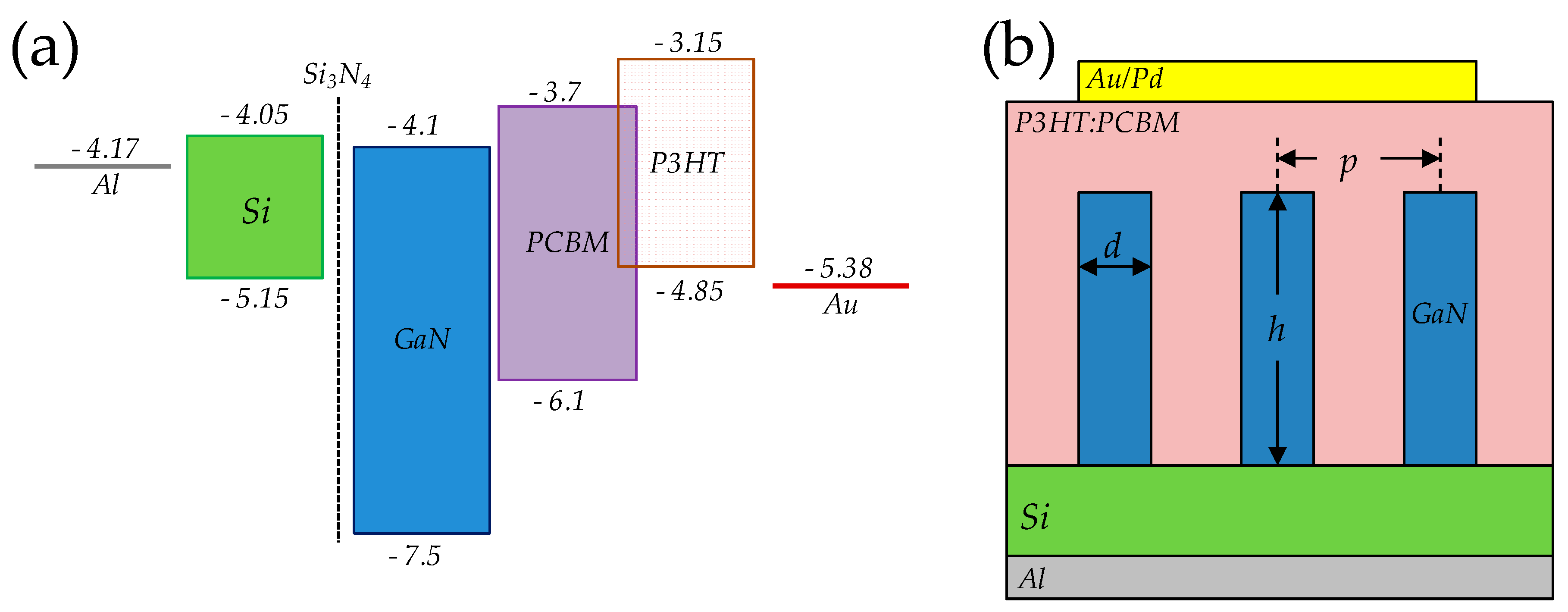
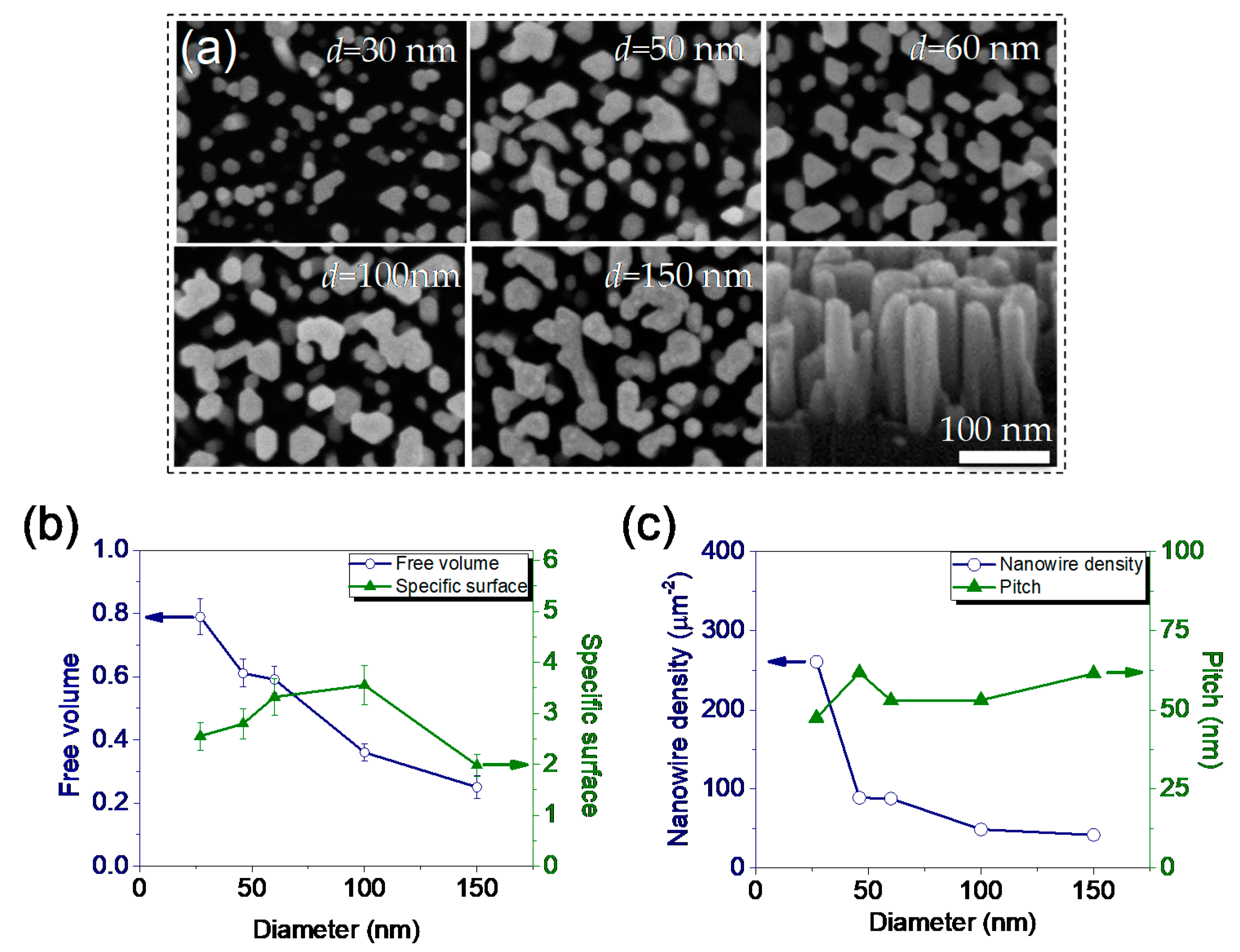
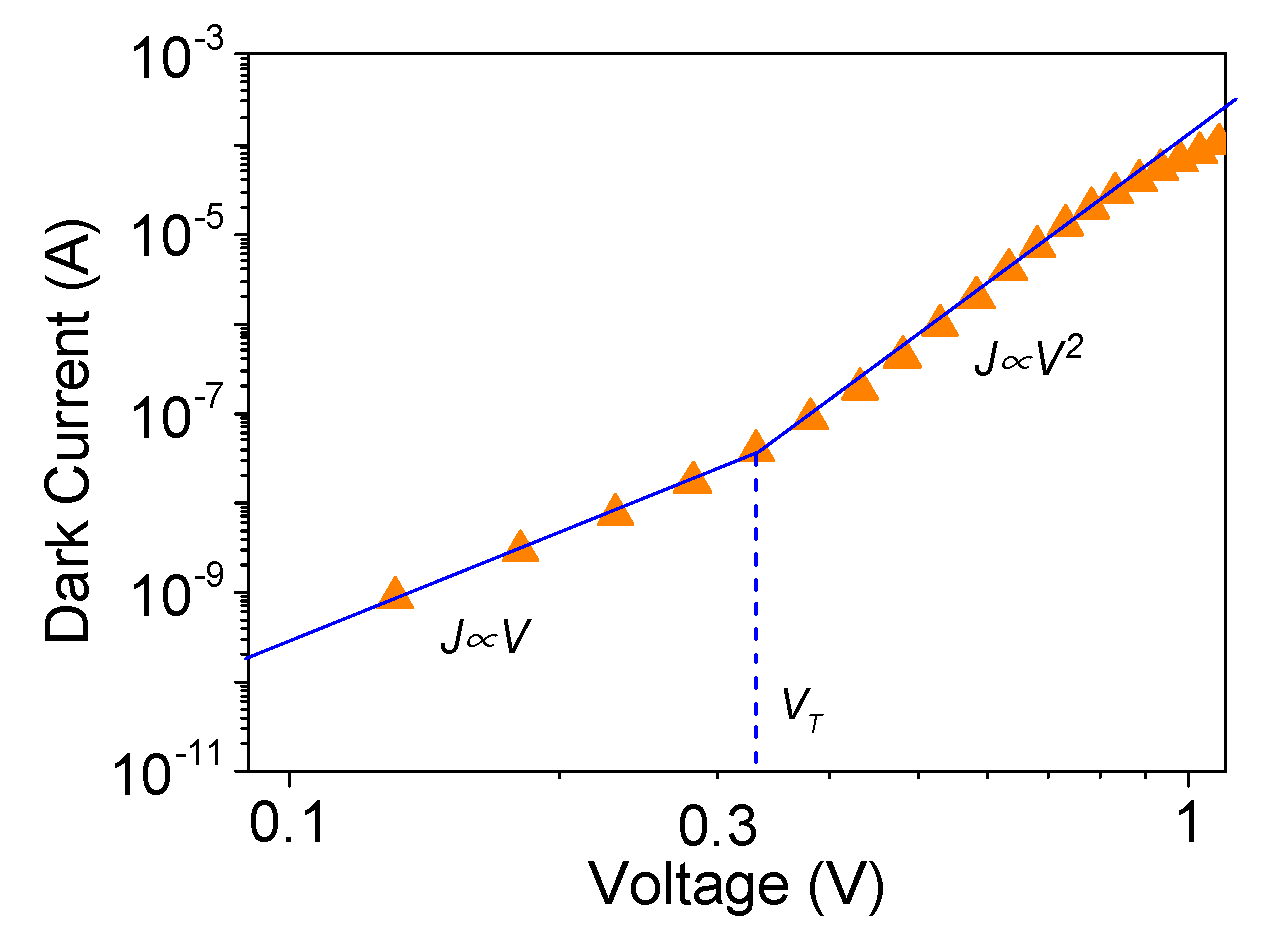

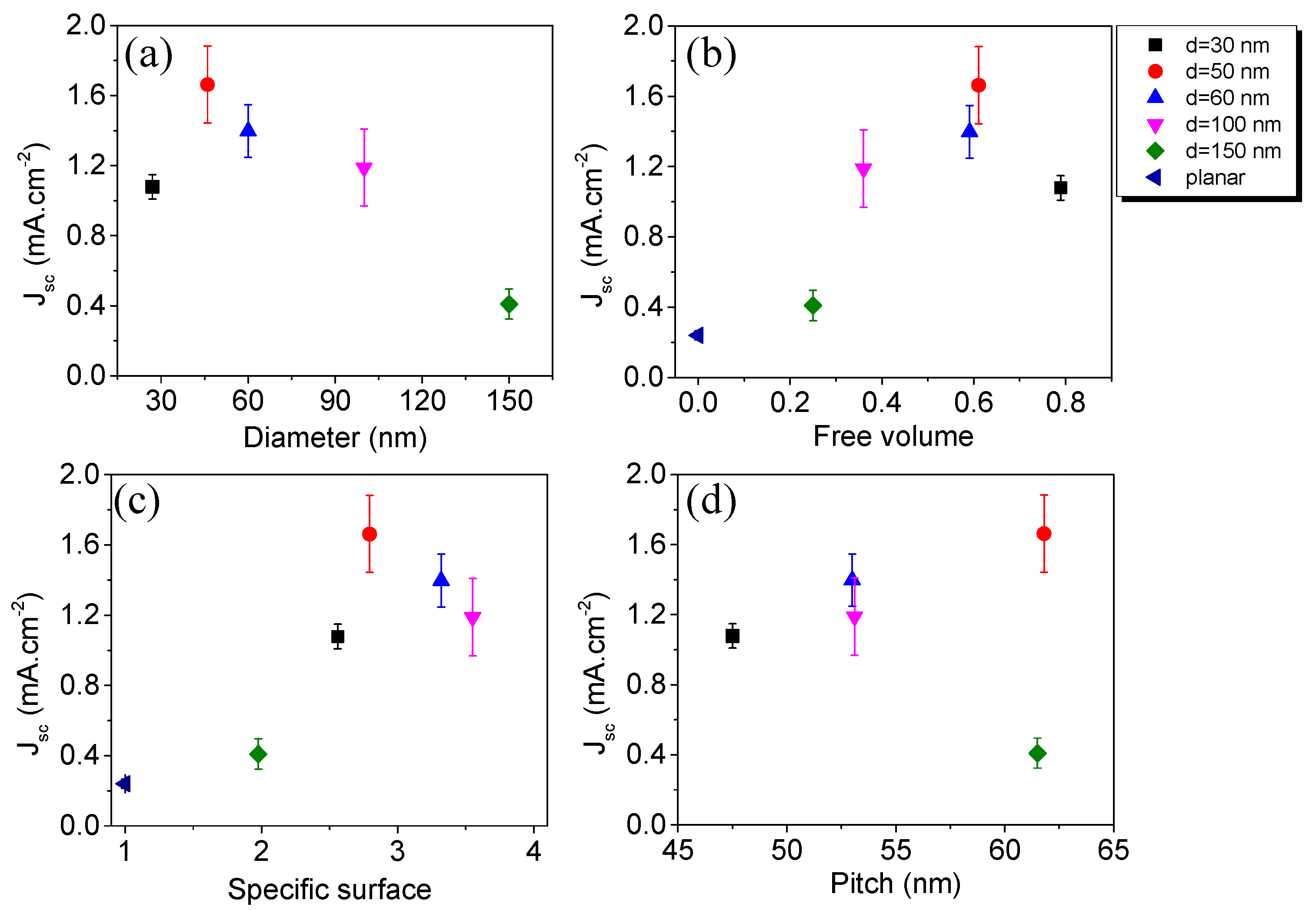
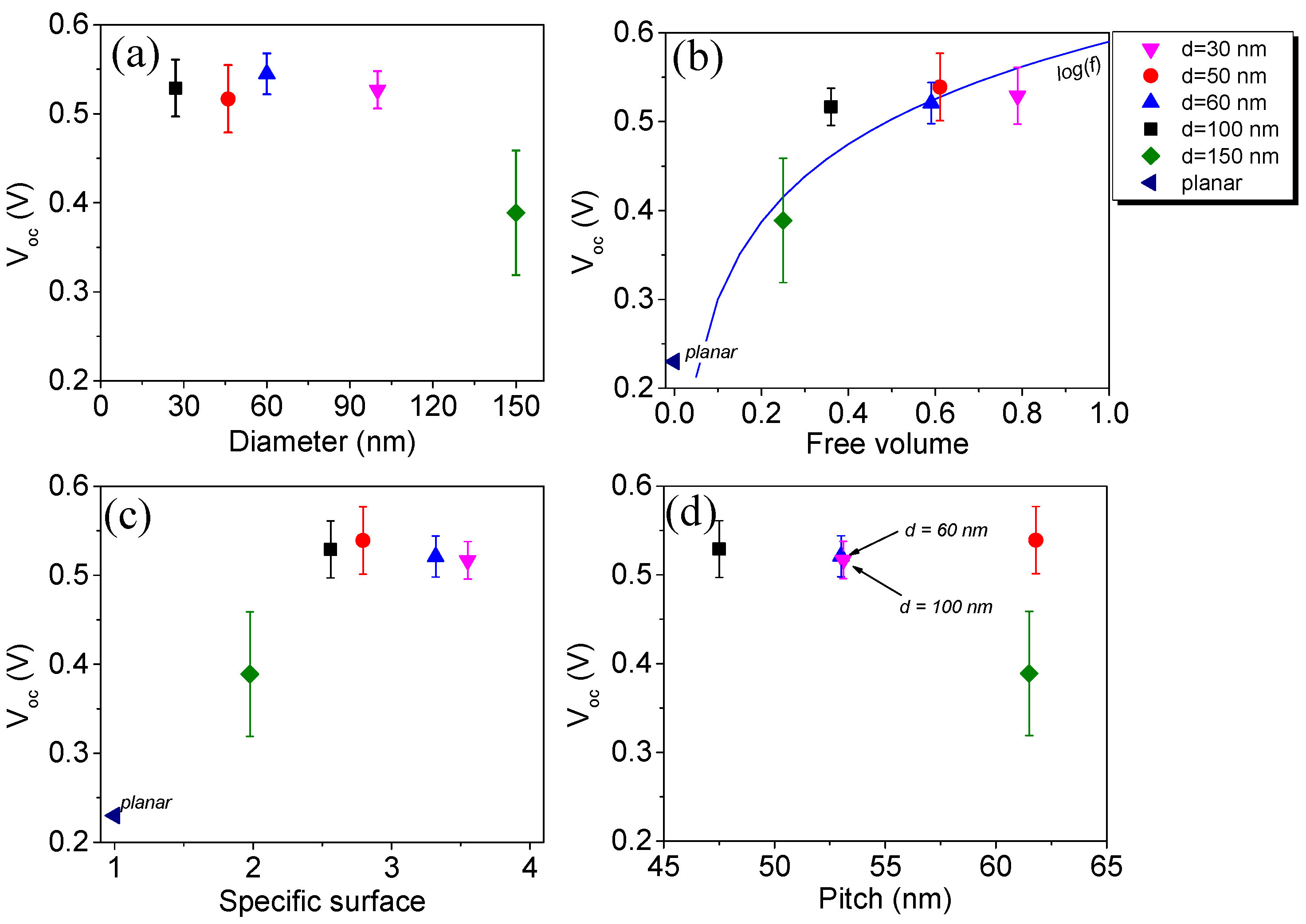

| Structure | Jsc (mA·cm−2) | Voc (V) | Fill Factor | PCE (%) | Rs (Ω) | Rsh (Ω) |
|---|---|---|---|---|---|---|
| D30 | 1.09 (±0.07) | 0.53 (±0.03) | 0.44 | 0.25 | 200 | 1460 |
| D50 | 1.69 (±0.22) | 0.52 (±0.04) | 0.49 | 0.42 | 140 | 1200 |
| D60 | 1.33 (±0.15) | 0.54 (±0.02) | 0.44 | 0.34 | 250 | 1340 |
| D100 | 1.18 (±0.22) | 0.52 (±0.02) | 0.49 | 0.42 | 155 | 1520 |
| D150 | 0.41 (±0.09) | 0.39 (±0.07) | 0.41 | 0.07 | 695 | 1280 |
| planar | 0.24 (±0.02) | 0.23 (±0.01) | 0.27 | 2 × 10−4 | 655 | 1280 |
| Structure | Vbi (V) | |Na−Nd|(cm−3) |
|---|---|---|
| D30 | 0.24 | 6.1 × 1017 |
| D50 | 0.25 | 5.9 × 1017 |
| D60 | 0.36 | 5.7 × 1017 |
| D100 | 0.3 | 2.6 × 1017 |
| D150 | 0.32 | 7.1 × 1016 |
Publisher’s Note: MDPI stays neutral with regard to jurisdictional claims in published maps and institutional affiliations. |
© 2020 by the authors. Licensee MDPI, Basel, Switzerland. This article is an open access article distributed under the terms and conditions of the Creative Commons Attribution (CC BY) license (http://creativecommons.org/licenses/by/4.0/).
Share and Cite
Tchutchulashvili, G.; Chusnutdinow, S.; Mech, W.; Korona, K.P.; Reszka, A.; Sobanska, M.; Zytkiewicz, Z.R.; Sadowski, W. GaN Nanowire Array for Charge Transfer in Hybrid GaN/P3HT:PC71BM Photovoltaic Heterostructure Fabricated on Silicon. Materials 2020, 13, 4755. https://doi.org/10.3390/ma13214755
Tchutchulashvili G, Chusnutdinow S, Mech W, Korona KP, Reszka A, Sobanska M, Zytkiewicz ZR, Sadowski W. GaN Nanowire Array for Charge Transfer in Hybrid GaN/P3HT:PC71BM Photovoltaic Heterostructure Fabricated on Silicon. Materials. 2020; 13(21):4755. https://doi.org/10.3390/ma13214755
Chicago/Turabian StyleTchutchulashvili, Giorgi, Sergij Chusnutdinow, Wojciech Mech, Krzysztof P. Korona, Anna Reszka, Marta Sobanska, Zbigniew R. Zytkiewicz, and Wojciech Sadowski. 2020. "GaN Nanowire Array for Charge Transfer in Hybrid GaN/P3HT:PC71BM Photovoltaic Heterostructure Fabricated on Silicon" Materials 13, no. 21: 4755. https://doi.org/10.3390/ma13214755





